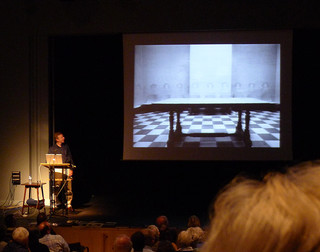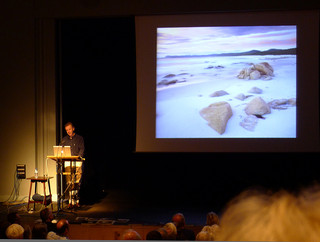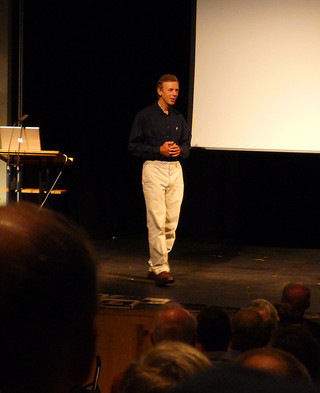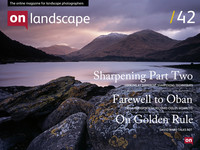Michela Griffish reports on a recent talk in Buxton by Joe Cornish

Michéla Griffith
In 2012 I paused by my local river and everything changed. I’ve moved away from what many expect photographs to be: my images deconstruct the literal and reimagine the subjective, reflecting the curiosity that water has inspired in my practice. Water has been my conduit: it has sharpened my vision, given me permission to experiment and continues to introduce me to new ways of seeing.

Joe Cornish
Professional landscape photographer.
We have a visitor to Joe’s gallery in North Allerton last year to thank for Joe’s appearance for one of the talks at the annual Buxton Festival. Many of us have a book or two or more by Joe on our shelves and possibly an equal number have dreamed “one day….,” so the chance to hear Joe talk on this subject just “up t’ road” was not to be missed.
Half an hour before the advertised start, there were already brisk sales of Joe’s books in the foyer. Fortunately Joe was on hand to clarify that the box of books under the table were not for sale, but his personal archive - a back-up in case of tech gremlins and an aide-memoire. Laid out, they filled the width of the stage, a reminder that as well as his well-known landscape photography books, Joe has contributed to many travel books too.

On a weekend when the sun returned, Joe managed to entice around 200 people to sit in a darkened room. Perhaps he brought the sun back with him, or maybe as he joked Buxton really is the Verona of the North. As one of the literature events for the festival, there was perhaps a question of whether those present were interested in books, or photography, or both, and this must have made it a little difficult to judge the ‘pitch’ for Joe’s first talk about landscape photography books, rather than landscape photography per se. It was interesting to note that for a genre that is often dominated, at least in the media, by men, there was a balance between men and women in the audience. As Joe waited at the side of the stage to start, I heard a lady behind me ask her companion “Is that him? He doesn’t look old enough to be a photographer.” Joe will doubtless modestly say that the lights were low, but he does look well on it, and exudes enthusiasm for his subject.
For anyone serious about their photography, at least in the days before everything went World Wide Web, books quickly became an important source of knowledge and inspiration. Somewhere between the landscape photography books I bought as a sixteen year old and my reconnection with the subject in the ‘noughties’ a step change had taken place in the quality of photographic books, and Charlie Waite, Joe and David Ward were prominent in this. So Joe’s first slide – to the effect that he had learnt about landscape photography through books – had a particular resonance for me.

Joe spoke of his early influences including Ansel Adams, Edward Weston and John Blakemore – important not just for their pictures, but for their way of thinking about photographs. Others included W Eugene Smith, Eliot Porter, Galen Rowell and Peter Dombrovskis. On one occasion he spent a whole week’s wages on an Eliot Porter book, and I think we sometimes overlook the now relatively modest cost of many photography books.
We perhaps also fail to appreciate the groundwork that Joe put in as a photographer’s assistant, commercial and travel photographer. Early on, he noted that the most important thing that he learned was where to stand. Joe touched on key stages in his career as a photographer and as a writer, which he admits was not initially on his radar. He noted that of photographers’ propensity to grumble when they meet up, the topic that they most complain about is authors. I have met others who have said that the ability to write good copy is as important as the ability to make good images.
Joe received the sum of £600, excluding expenses, for his first, largely black and white, photography book which was published in 1986. Then followed a series of travel books, mostly of European destinations; each took many weeks and while finances were very tight, these were important to his development, though Joe expressed some guilt about the associated carbon footprint.

A meeting with Eddie Ephraum’s, then a publishers’ assistant, was clearly fortuitous and led to his first landscape photography book in 2002 - “First Light” – which drew on his portfolio of work. Joe is right to still feel fairly happy about this and it definitely bears re-reading. Joe emphasised the importance of working as part of a creative team, in contrast to an often solitary presence on the field, but noted with some regret that this was the last book of his to be printed using offset reprography and with what now seems like the luxury of an expert scanner and Photoshop operator. Subsequently, the flexibility that computers brought led publishers to make their photographers responsible for image reproduction and colour management which as well as being very time consuming could be particularly challenging when the printer was overseas (“Scotland’s Coast”). This was an experience that Joe was keen not to repeat, and for “Scotland’s Mountains” he undertook colour management training.
Taking the images for “Scotland’s Coast” involved 18,000 miles of travel to do justice to a 4,000 mile coastline. For “Scotland’s Mountains” the images were taken during the course of 2 years with the 5 x 4 camera alone contributing 16kg to pack weight. So we should not underestimate either the time or the physical effort involved in producing the images for these.
Joe touched on the pros and cons of publishers and self-publishing. He then talked about how digital readers had revolutionised the book world, commenting that it was not yet clear if this was a challenge or an opportunity. He hoped for an outcome similar to the reinvigoration that photography gave to painting, by freeing fine arts from their traditions, but admitted some concern. While digital media and self-publishing now allow us all to become publishers, there is a significant difference between this limited print route (and challenge in marketing) in comparison to a typical publisher’s run of between 2,000-4,000 but with the reassurance of their publicity and marketing machine.
Joe ended his talk by expressing a hope that there will not be an end to ‘real’ books, rightly noting that physical and sensory interaction is an important part of the joy of reading.
Overall it was an enjoyable hour, illustrated with images from throughout Joe’s career, including some from his degree show. It was interesting to see that these already hinted at the style for which Joe has become well known, with an emphasis on foreground interest. The talk perhaps only touched on the wealth of knowledge that Joe has built up on the subject which I am sure would make a fascinating workshop specifically for landscape photographers. It was delivered with good humour and considerable enthusiasm for his subject, and offered insights into his way of working. I took away a better understanding of how much work goes into producing a book; that if we wish to follow we should have a very clear idea of who will buy it; and that if we value books, we should keep buying them.

